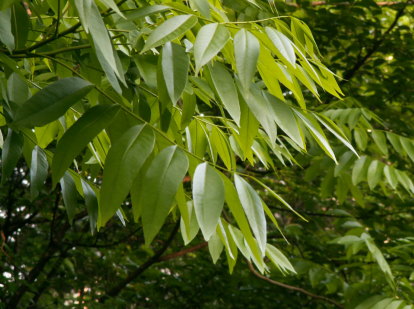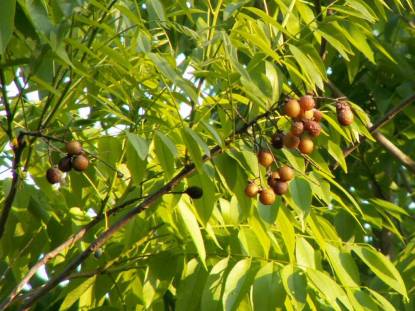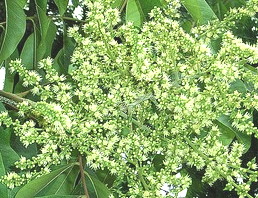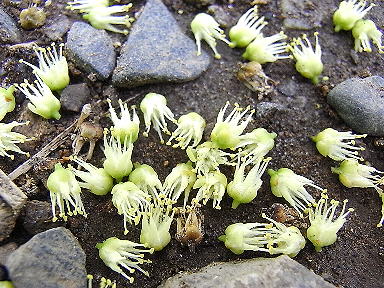
| MENU | |||||||
| 1) scientific name and common name 2) not nuts, but fruits 3) fellow plants 4) soapnut tree 5) soapnut flower and fruit |
6) about saponin 7) to clean anything 8) smell, suds 9) to make soapnut liquid 10) references |
||||||
1) scientific name and common name People call them soapnuts, soapberry, washnuts or reetha. It has a wide variety of scientific names, depending on where it came from; SAPINDUS DELAVAYI (China, India), SAPINDUS DRUMMONDII(Southern U.S., Mexico), SAPINDUS EMARGINATUS(Southern Asia), SAPINDUS MARGINATUS(Florida to South Calorina, U.S.), SAPINDUS MUKOROSSI(Southern china west to the Himalayas), SAPINDUS OAHUENSIS(Hawaii), SAPINDUS RARAK(Southeast Asia), SAPINDUS SAPONARIA(Florida Keys, Caribbean, Central Ameria), SAPINDUS TOMENTOSUS(China), SAPINDUS TRIFOLIATUS(Southern India, Pakistan). In Japan, people call them "MU-KU-RO-JI". They grow in Honshu, Shikoku, Kyushu and Okinawa. It is written in chinese characters as "無患子" which means children do not get sick. The name may come from the history that soapnuts had been employed as a herb medicine. They gathered its outer skins and dried them in the sun to make the chinese medicine "EN-MEI-HI", which is applied as tonic, hemostatic, antiinflammatory, or for antibacteria, or, for treatment for rheumatism, bronchitis, soa throat, cough and phlegm. |
|||||||
2) not nuts, but fruits Soapnuts are called "nuts" but are not botanically related to the nut family. They are fruits. The outer skin of the fruit, after being produced, becomes dry and hard under the sunshine, that might be the reason why people call them nuts. Nanurally, soapnuts are absolutely harmless to people who are allergic to nuts. |
|||||||
3) fellow plants Soapnut tree is dicotyledon and belongs to genus sapindus, which has many species of shrubs and small trees, and is native to the warm temperate - tropical regions. In Japan, some species grow and, among them, two are popular and called MUKUROJI and MOKUGENJI. There are some popular fruit trees in sapindus family, litchi, rambootan and longan. Most of species content saponin. Among them, soapnuts are well-known as the substitute for soap. |
|||||||
4) soapnut tree Soapnut tree reaches 15 to 25 meters in height with broad, sometimes about an equal spread, forming almost symmetrical fugure. Western soapberry trees (Sapindus Drummondii) which grow in Northern America, being planted for buffer strips around parking lots, medium strip plantings in highway, and sidewalk cutouts in residential streets, are making good shades. They can grow in areas with poor drainage, compacted and/or draughty soil. |
|||||||
    leaves nuts (fruits) flowers fallen flowers |
|||||||
5) soapnut flower and fruit Small creamy-yellowish-white blooms appear in spring and early summer, followed by translucent, yellowish orange grean half-inch clustered fruits, whose smooth outer skin becomes dark in color, dried and wrincled in the sun. Soapnut fruit drops while it is firm and does not rot to create a mess. |
|||||||
6) about saponin Soapnut's outer skin, or shell, is rich in saponin, the natural water surfactant. The name saponin is derived from the latine word "soap". It is a frothing agent when diluted in aqueous solution. Structurally it is amphipathic glycosides composed of one or more hydrophilic and hydrophobic glycoside combined with a lipophilic triterpene derivative. The combination of sapogenin, hydrophobic or fat-soluble, hydrophilic or water-soluble sugar part enhances the foaming ability of saponin. The mechanism how saponin foams are the same as how soap does, but there is a difference that saponin is nonionic as well as neutral. Saponin does not reduce water tension so much as soap does. In all over the world, plants, containing saponin, have been used as a soap substitute. Saponin is a unique natural material which produce suds and it may cause the lysis of red blood cells, hemolysis. That was why saponin had been used for making arrow poisons. It is interesting that saponin is toxic to cold-blooded creatures like snake and fish and has been applied for catching them. Saponin is a phyto-chemical. Various plants and vegetables contain saponin in their roots, leaves, bulbs, blossoms, fruits and stems. It sometimes makes the food bitter to taste. It is necessary to remove the bitter taste well before eating the food, containing saponin, to avoid toxicity It has been noticed that saponin has various physiological activating effects, for example, to control blood cholesterol level, liver disorder, blood circulation, anti-inflammatory effects, stimulation of expectoration, anti-aging. |
|||||||
7) to clean anything In Hindu, soapnut is called RITTHA. Soapnut fruits have been used as a soap substitute and for polishing gold, silver and jewellery. They have been used to wash valuable and fine fabrics as they clean silks and wool safely. It is said, that, in ancient days, passengers of Indian pilgrim ship were requested to carry soapnuts onboard for hygiene and purity. Soapnut extract is proved to be hypoallergenic and antibacterial. It is employed for the production of toothpaste and kitchen cleansers. Some people simmer 50g of soapnut in 1 litter of water for 10 min. to make liquid soap and use it for laundry, kitchen, house cleaning, car wash and to wash other various kind of things. Quite a few people use soapnuts as a pet shampoo as it is mild and softening. |
|||||||
8) smell, suds Soapnuts have an original vinegary scent like cider, however, no smell is left after washing with soapnuts. Soapnuts are natural and so does saponin, comming out from soapnut skin. That is why not much suds are produced as other chemical detergent does. |
|||||||
9) how to make soapnut liquid Boil 12-15 pieces of soapnut in 6 cups of water for 30 minuites. If you do not add any water while boiling, there will be about 4 cups of soapnuts liquid. Add water if you like. Remove soapnuts when cooled. Pour the liquid in the plastic or glass airtight jar. It is recommended to devide the liquid into some jars to keep it from the contamination while using. The more concentrated liquid will be obtained if you boil with 3 cups of water instead of 6. You may try in various ways, depending on what you prefer and what you need for the purpose of use. TIP: Freeze the liquid in ice cube trays for the preservation. 2-3 cubes will be fine for the standard household washer. |
|||||||
10) references wildflower.org/plants (Nature plant database) Western Soapberry by Edward F. Gilman & Dennis G. Watson (Fact Sheet ST-581, a series of the Environmental Horticulture Dept., Florida Cooperative Extension Service, Institute of Food and Agricultural Sciences, University of Florida. Oct., 1994) herbs2000.com gogreen.cellande.co.uk studioomshop.com laundrytree.com en.wikipedia.org ja.wikipedia.org e-yakusou.com kenko.it-lab.com buysoapnuts.com/howtouse.html odn.ne.jp/~had26900/constituents/mechan_saponins.htm |
|||||||
